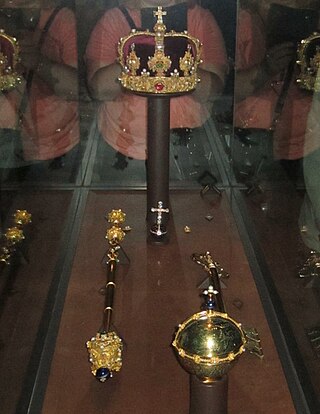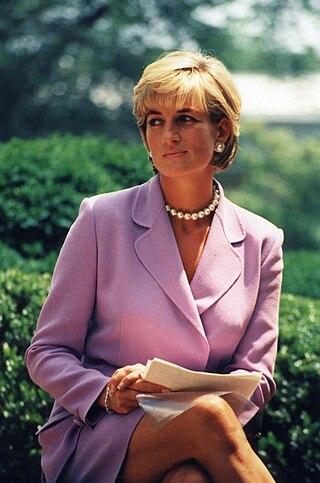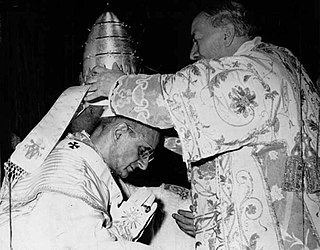
Crown jewels are the objects of metalwork and jewellery in the regalia of a current or former monarchy. They are often used for the coronation of a monarch and a few other ceremonial occasions. A monarch may often be shown wearing them in portraits, as they symbolize the power and continuity of the monarchy. Additions to them may be made, but since medieval times the existing items are typically passed down unchanged as they symbolize the continuity of the monarchy.

The Imperial Crown of India was used by King George V in his capacity as Emperor of India at the Delhi Durbar of 1911.

The Crown Jewels of the United Kingdom, originally the Crown Jewels of England, are a collection of royal ceremonial objects kept in the Jewel House at the Tower of London, which include the coronation regalia and vestments worn by British monarchs.

St Edward's Crown is the centrepiece of the Crown Jewels of the United Kingdom. Named after Saint Edward the Confessor, versions of it have traditionally been used to crown English and British monarchs at their coronations since the 13th century.

The Imperial State Crown is one of the Crown Jewels of the United Kingdom and symbolises the sovereignty of the British monarch. It has existed in various forms since the 15th century. The 1937 version is worn by a new monarch for the first time in the royal procession following their coronation and subsequently used at State Openings of Parliament. The crown is adorned with 3,170 precious stones, including the Cullinan II diamond, St Edward's Sapphire, the Stuart Sapphire, and the Black Prince's Ruby.

The Honours of Scotland, informally known as the Scottish Crown Jewels, are the regalia that were worn by Scottish monarchs at their coronation. Kept in the Crown Room in Edinburgh Castle, they date from the 15th and 16th centuries, and are the oldest surviving set of crown jewels in the British Isles.

The French Crown Jewels and Regalia comprise the crowns, orb, sceptres, diadems and jewels that were symbols of Royal or Imperial power between 752 and 1870. These were worn by many Kings and Queens of France as well as Emperor Napoleon. The set was finally broken up, with most of it sold off in 1885 by the Third Republic. The surviving French Crown Jewels, principally a set of historic crowns, diadems and parures, are mainly on display in the Galerie d'Apollon of the Louvre, France's premier museum and former royal palace, together with the Regent Diamond, the Sancy Diamond and the 105-carat (21.0 g) Côte-de-Bretagne red spinel, carved into the form of a dragon. In addition, some gemstones and jewels are on display in the Treasury vault of the Mineralogy gallery in the National Museum of Natural History.

The Bavarian Crown Jewels are a set of crown jewels created for the Kingdom of Bavaria, which existed from 1806 to 1918. In 1806, as part of his wholescale re-ordering of the map of Europe, Emperor Napoléon I of the French upgraded the independent German duchy of Bavaria to full kingdom status. The former Duke of Bavaria, now King of Bavaria, Maximilian I, commemorated the fact by commissioning a set of crown jewels for use by Bavarian monarchs. However, there was no coronation ceremony, and the king never wore the crown in public. Rather, it was placed on a cushion when displayed on occasions such as the king's ascension or his funeral.

The State Crown of Mary of Modena is the consort crown made in 1685 for Mary of Modena, queen of England, Scotland and Ireland. It was used by future queens consort until the end of the 18th century.

The Bohemian crown jewels, also called the Czech crown jewels, include the Crown of Saint Wenceslas, the royal orb and sceptre, the coronation vestments of the Kings of Bohemia, the gold reliquary cross, and St. Wenceslas' sword. They were originally held in Prague and Karlštejn Castle, designed in the 14th century by Matthias of Arras. Since 1791 they have been stored in St. Vitus Cathedral at Prague Castle. Reproductions of the jewels are permanently exhibited in the historical exposition at the former royal palace in the castle. The crown was made for the coronation of Charles IV in 1347, making it the fourth oldest in Europe.

The Crown of Queen Adelaide was the consort crown of the British queen Adelaide of Saxe-Meiningen. It was used at Adelaide's coronation in 1831. It was emptied of its jewels soon afterwards, and has never been worn since.

The Coronet of Charles, Prince of Wales is a small crown that is part of the Honours of Wales. The gold coronet, with diamonds set in platinum, was made for and used by King Charles III at his investiture as Prince of Wales in 1969. Designed by the artist Louis Osman, the coronet was a gift from the Worshipful Company of Goldsmiths to the Prince's mother, Queen Elizabeth II. It has been described as modern but its form is traditional. The coronet is on permanent display in the Jewel House at the Tower of London.

The Coronation Crown of George IV is an elaborate coronation crown made specially for George IV, King of the United Kingdom, in 1821.

The Royal Crown of Serbia is a royal regalia that existed during the Serbian monarchy.

Sweden's regalia are kept deep in the vaults of the Royal Treasury, underneath the Royal Palace in Stockholm, in a museum that is open to the public. The crowns and coronets have not been worn by Swedish royalty since 1907, but they are still displayed at weddings, christenings and funerals.
Sir John Spilman was a Lindau, German-born entrepreneur who founded the first commercially successful paper-mill in England, establishing a factory on the River Darenth in Dartford, Kent in 1588. Spilman was also jeweller to Queen Elizabeth I, and was knighted by King James I.

Queen Elizabeth II owned a historic collection of jewels – some as monarch and others as a private individual. They are separate from the gems and jewels of the Royal Collection, and from the coronation and state regalia that make up the Crown Jewels.

The Crown of Princess Blanche, also called the Palatine Crown or Bohemian Crown, is the oldest surviving royal crown known to have been in England, and probably dates to 1370–80.

Diana, Princess of Wales, owned a collection of jewels both as a member of the British royal family and as a private individual. These were separate from the coronation and state regalia of the crown jewels. Most of her jewels were either presents from foreign royalty, on loan from Queen Elizabeth II, wedding presents, purchased by Diana herself, or heirlooms belonging to the Spencer family.

Paul VI was crowned as Pope on 30 June 1963 at Vatican City's St. Peter's Square, nine days after he was elected. The representatives of over 90 countries and international organizations were present at the coronation. The Pope was crowned with a jewelled, but lightweight custom-made tiara. The centuries-old practice of inaugurating a papacy with a papal coronation lapsed thereafter as his successors, beginning with John Paul I, adopted simpler ceremonies that did not include the imposition of a tiara.



















